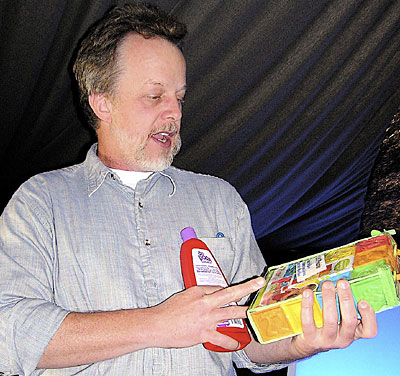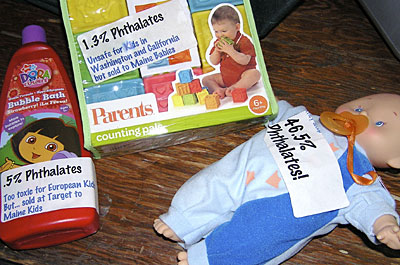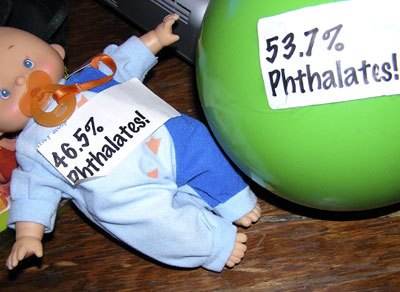 |
| Mike Belliveau of the Environmental Health Strategy Center said that the Center tested consumer products for toxic phthalates this year and found them in 20 of 24 products tested, including children’s toys and a raincoat. English photo. |
Melissa White Pillsbury, organic marketing coordinator for MOFGA, described challenges she and her husband faced while build a new house and anticipating the birth of their first child. “I’m more aware of the chemicals in my environment since I became pregnant,” she said, noting that finding healthy foods is fairly easy, but choosing other products is not. For her new home, she focused on items that her family would contact directly, such as countertops, carpeting, upholstery and bedding.
“Even that wasn’t straightforward.” When she looked for a carpet locally that hadn’t been treated with flame retardants or stain-resistance chemicals, the information was inaccessible. “The carpet or upholstery industry has gone ‘green’ by using recycled or recyclable materials, but they don’t seem to consider all these treatments.” She did find a carpet without stain-resistant chemicals but could not determine whether it been treated with flame retardant. (Ed. note: Coop America, at coopamerica.org, lists truly green products available in some U.S. locations; and the Folk Arts Area of the Common Ground Fair demonstrates rug braiding and hooking.)
Consumer Products
 |
| Children’s products containing phthalates. English photo. |
The Center found phthalates in 20 of 24 products it had tested. A child’s vinyl raincoat was almost 1% phthalates; a rubber ball – 53.7%; a counting toy – 1.3%; Adora the Explorer Bubble Bath – 0.5%; Baby I’m Yours Beanbag Doll – 46.5%. “These are very high numbers,” said Belliveau. “Nothing on the label will give you any information about this. We’re surrounded with chemicals in everyday products, because our safety system at the federal level is so badly broken.” Of the products the Center had tested, 57% had levels of phthalates above those allowed in Europe. California and Washington state laws that become effective next year will ban the sale of such products. Maine is working on similar legislation.
Congress enacted some legislation on lead and phthalates in children’s products last year, which the chemical industry is trying to undo. “If we can make it stick, these products will be off the market in the United States, but not for several years,” said Belliveau. Most are made in China for U.S.-based corporations.
 |
| English photo. |
These hormone mimics act at tiny doses and may affect thyroid functioning. “If you have a baby in the womb with a low thyroid, they’re going to be born with a damaged brain,” noted Belliveau. BPA has also been linked to changes in the prostate gland and in breast development that are probably linked to breast and prostate cancers.
Dozens of peer reviewed studies with various species have found adverse effects of BPA at levels below FDA’s current “safe” level, but FDA uses only two chemical industry-funded studies that found no ill effects – another symptom of a badly broken system, said Belliveau. “The Toxic Substances Control Act, passed in 1976, is the only federal environmental law that has never been updated – and the chemical industry likes it that way.”
Phthalates and BPA are just two of some 62,000 chemicals in commerce that haven’t been adequately tested. “We can’t keep tackling them one at a time,” said Belliveau. “Because of the work of the Alliance for a Clean and Healthy Maine, we passed a law in Maine to begin to fix our broken safety chemical system.” It requires listing chemicals that we know might threaten children’s health that are high priority, forcing product manufacturers to tell when those chemicals are in products for the first time; the state can then require a safer alternative, if available. Candidate chemicals include phthalates, BPA, flame retardants, Teflon – “There’s no shortage.”
Noting that “we need that kind of law at the federal level.,” Belliveau urged people to tell Maine’s four U.S. legislators that they’re concerned about BPA in plastic baby bottles even though the federal government saying it’s not a problem; that Congress should ban the chemical (safer alternatives exist); and that the broken chemical safety system should be fixed, using the Maine model.
Plenty of Reason to Eat Organic Foods
Heather Spalding, associate director of MOFGA, noted many reasons to feed children (and others) organic foods, citing statements and peer-reviewed scientific studies gathered by The Organic Center (organic-center.org). For example:
Toxicopathologist Dr. Vyvyan Howard at the U.K.’s University of Liverpool says: “People are applying the precautionary principle to their own lives by purchasing food that has not been produced by industrial methods. From the simple stance of hazard avoidance, organically produced food is the best option that we have.”
The British Medical Association says: “Until we have a more complete understanding of pesticide toxicity, the benefit of the doubt should be awarded to protecting the environment, the worker, the consumer. This precautionary approach is necessary because the data on the risks to human health from exposure to pesticides are incomplete.”
USDA data show significant declines in mineral concentrations in produce, meat and dairy since the 1940s – yet a study done at Highmoor Farm in Monmouth, Maine, in the 1970s by Frank Eggert found greater mineral concentrations in organically produced carrots than in conventional carrots.
The Organic Center cites numerous studies showing greater concentrations of essential nutrients and of cancer-fighting antioxidants in organic foods.
Swiss researchers found that mothers consuming mostly organic meat and milk products had about 50% more rumenic acid in their breast milk – a conjugated linoleic acid (CLA) responsible for most of the health benefits of CLAs in milk and meat.
The British Journal of Nutrition (June 2007) reported that when cows relied more on pasture and forage grasses, concentrations of CLA in milk and beef (and in the breast milk of women eating these organic foods) increased.
The Organic Center says that converting 3% of U.S. agricultural acreage (the acreage used to grow produce) to organic production would eliminate 97% of our pesticide exposure. West of the Mississippi, systems are in place to make most of these changes; some crops in the East face challenging pest pressure, “but MOFGA knows from experience that every crop grown in Maine can be grown organically,” said Spalding.
University of Washington researchers found that feeding school-age children predominantly organic food produces a dramatic, immediate protective effect against exposure to organophosphate (OP) pesticides. About 70% of insecticides used in the United States are OPs–neurotoxins that interfere with the nervous system of insects, and children. OP-treated commodities most commonly eaten by children are peaches, apples, grapes, green beans and pears. The EPA has banned most residential uses the highly toxic OP chlorpyrifos, but it’s still one of the most commonly used pesticides in Maine.
A National Institute of Health study indicated that pesticide exposure increases the risk of gestational diabetes in women.
The Organic Center says that children’s immature, developing organs, brains and detoxification and immune systems, combined with their larger intake of food per unit of body weight, make them more susceptible to toxins in conventionally produced foods. American toddlers eating mostly organic food have less than 1/6th the pesticide residues in their urine than children eating conventional foods.
In a Mexican village where pesticides were routinely used, children’s mental and motor abilities were far lower, and their aggressive behavior greater, than among children in a similar village where pesticides were not used routinely.
In a U.K. study, removing additives such as artificial colorings from diets halved the rate of hyperactivity in children.
Spalding noted that conventionally grown crops in Maine receive more than 1 pound of pesticide per year per Maine citizen – but organic foods are readily available here through more than 350 certified organic farmers in Maine; many more non-certified organic farmers; over 75 farmers’ markets, four year-round; and from over 115 CSAs that offer 4,000 shares, a majority producing organic foods. Maine also has dozens of natural food stores. MOFGA can help connect consumers with those foods. (See mofga.org.)
Local, Sustainable, Convenient, Affordable
Nancy Ross, professor of environmental policy at Unity College, spent a recent sabbatical studying food enterprises that use local, sustainably grown foods that are convenient and affordable. The highlight was the Riverside, California, school district where Rodney Taylor is instituting salad bars in elementary schools, serving 23,000 students. “Fifty to 60% of those students are from families that do not have fruit bowls sitting on the dining room table,” Ross noted.
The salad bar includes USDA commodity protein, grain and dairy, but strongly features local produce and is very selective about the USDA foods. “The children can go through the hot lunch line or the salad bar. Kids who go through the salad bar are getting much more produce than those who go through the hot lunch line. Rodney is well on the way to getting all 36 schools on the salad bar,” said Ross.
Most students and half the teachers choose the salad bar at least four times a week. Students value the fact that they can take as much as they want. For many, this is the only meal of the day.
When a new salad bar opens at a school, parents are invited to the opening and students visit the local farmers’ market. The salad bar is made attractive for everyone. For example, teachers can get their meals before kids handle the food (although students do sanitize their hands just before getting their food); and foods like jicama are offered the way Latinos like it – with lime and chili. A full-time nutritionist teaches kids about food; and the schools have gardens and composting programs.
“This huge school district relies on only three farms,” said Ross, which are saving open space in this very developed area where an acre of land may cost $1 million. One, the last citrus farm in an area that was once the citrus capital of the world, has hundred-year-old orange groves with fruits that are listed in Slow Food’s Ark of Taste. “They’re an international treasure,” said Ross. Taylor asked this grower if he could buy from him for the school district, “and that set in motion a whole new market for the orange grove,” said Ross. Some Riverside residents had never tasted a locally grown orange. “Now they have.”
Taylor pays farmers right away – not in 60 days, as other districts do. Menus revolve around available produce. Cafeteria and kitchen employees work harder because they’re happy to be involved in the program and they feel valued.
When Taylor began the program, Riverside had a $3.1 million deficit from foodservice. Grants funded the first salad bar, and Taylor increased prices on junk food and increased the cost of meals (children in need get free and reduced lunch) to pay more of the real cost. An entrepreneur, he also brings in over $1 million a year catering quality food to area nonprofits and businesses to help pay for the salad bar.
Taylor thinks a district with under 15,000 people will not have the resources for such a salad bar, but Ross believes that a creative model could work – “so long as you do the hard work.”
The Maine Harvest Lunch
Amanda Beal, president of MOFGA and director of the Communities Promoting Health Coalition of Healthy Maine Partnership, promotes healthier food in Maine schools. “Healthy Maine Partnerships does grassroots, community organizing,” she explained, “looking for where there’s energy to make change, and helping support citizens to do that. In many communities, especially rural communities, the school is a central place for community events.”
In 2003, working with a Soil and Water Conservation District educator, a teacher and food service director Ron Adams, Beal helped start a one-day Maine Harvest Lunch in a Gorham school. Classroom activities helped students understand the local lunch, and a poster contest helped kids express what they learned – and decorated the cafeteria on the day of the lunch. One way that Ron Adams reduced costs was by buying a CSA share from a local farm, taking his entire share in autumn.
Beal’s group soon got calls from others trying to do similar things, so they created k-8 lessons and a local foods directory for Cumberland County. (See www.mofga.org/Resources/MaineHarvestLunch/tabid/817/Default.aspx .) “We also held a networking dinner in Cumberland County for farmers and food service staff.” Some 80 people attended to discuss challenges and successes in connecting farms and schools.
The Maine Harvest Lunch strives to educate children, change the school nutrition program, increase community support and appreciation for community nutrition programs, and encourage people to think about nutrition as part of educational programming. School foodservice programs “shouldn’t run like a business,” Beal believes: “It’s an investment in the health and education of the next generation.”
The Maine Department of Education is challenging all schools to do a Maine Harvest Lunch. Over 200 participated last year. The Cumberland County effort has spread: Summer camps used Maine Harvest Lunch resources and created camp gardens; and community dinners have included the farmer directory.
Beal suggests that church suppers include at least one local dinner each summer; and that school kitchens become community kitchens in the summer for people who want to start businesses and/or for preserving local food for use during the school year.
